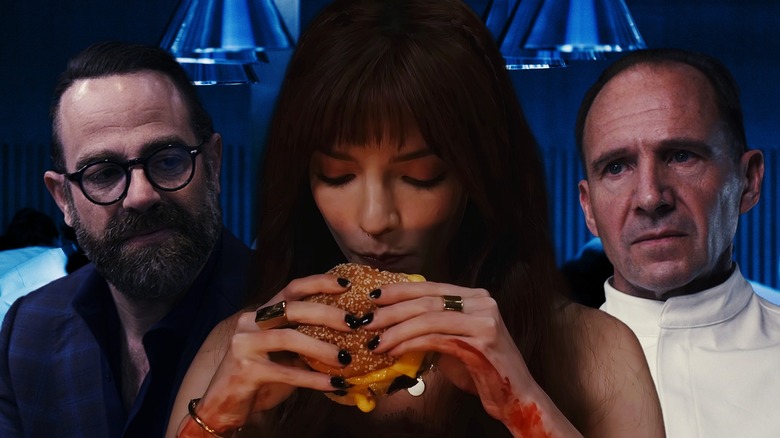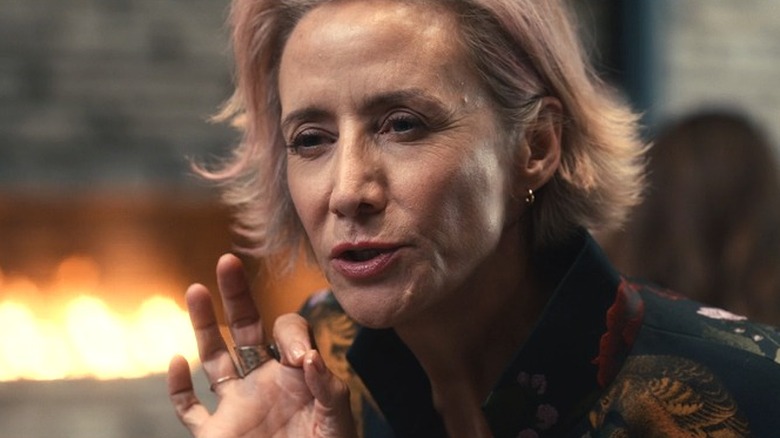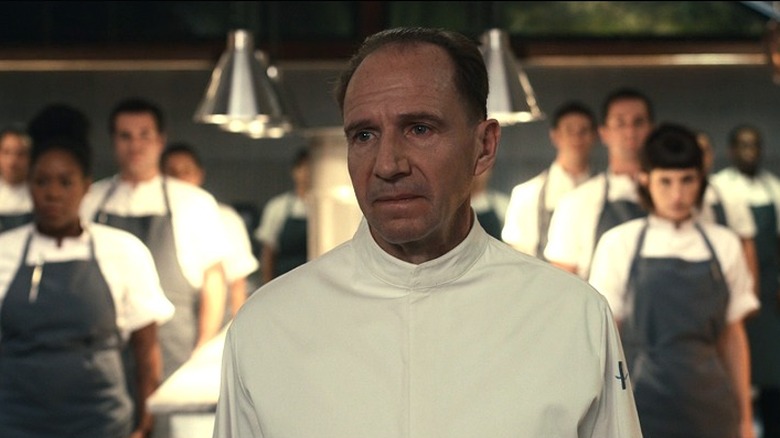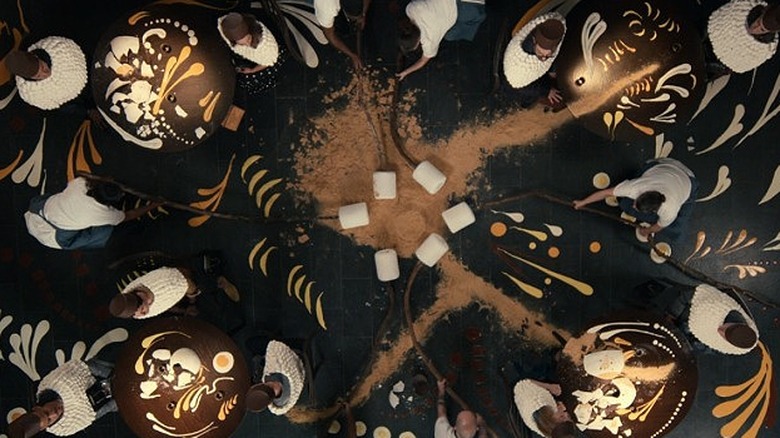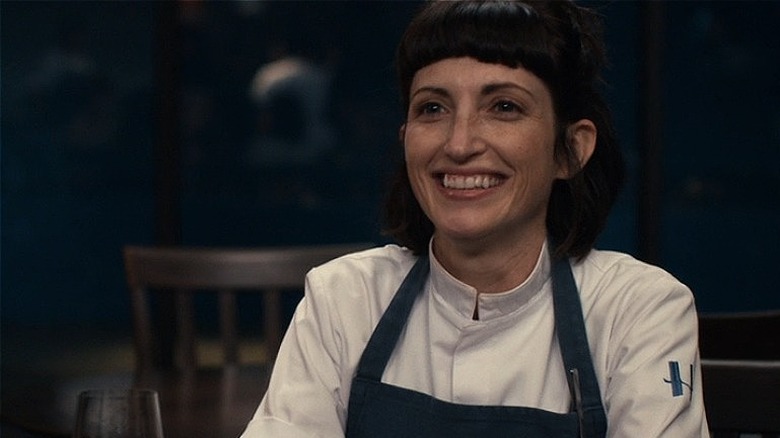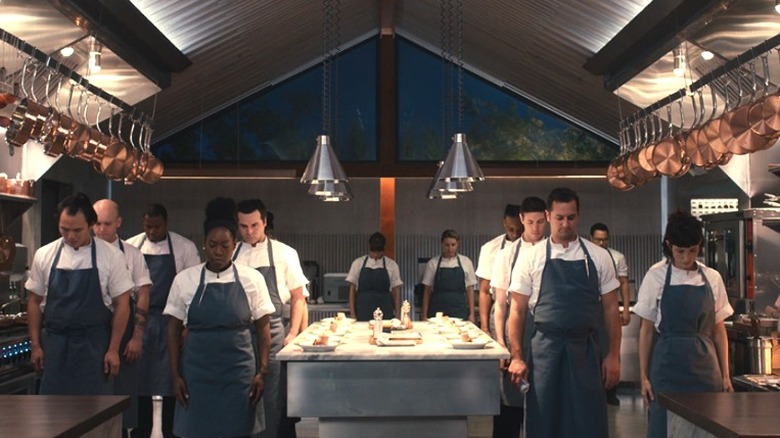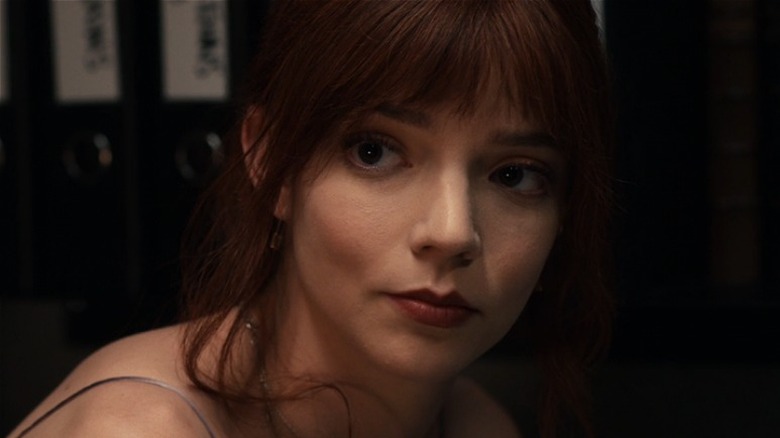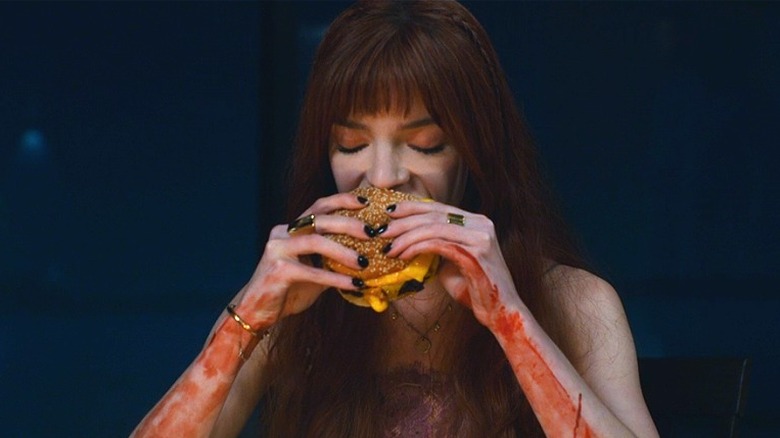Why The Menu Isn't The Movie People Think It Is
Great horror (hell, even bad horror, on occasion), by necessity, involves the viewer in its psychological experiment. Director Mark Mylod and writer Will Tracy's "The Menu" is no different. Howevr, rather than allow the average viewer to engage in the kind of rah-rah moral superiority that Dumb Rich People movies do, "The Menu" very intentionally doesn't let anyone off the hook. This universal skewering is a major element of the film, and yet, it's an element that's largely absent in the discourse surrounding it.
Much of what several prominent publications have said about "The Menu," including praise, relies on a surface-level understanding that, ironically, reinforces some of what the film's actually trying to say. These reviews — which tend to lump it in with other Eat the Rich narratives that don't tell us anything we don't already know, or chalk up its satirical focus to class division, or view it as an indictment of foodie culture, not to mention conflate Chef Solowik's (Ralph Fiennes) ranting with the film's own statement — either willingly ignore or miss entirely the story's exponentially more versatile, far-reaching, and relevant subtext.
Even though "The Menu" does indeed run on a particular representation of wealth and class divide, this is merely the language used to relay its thesis — it is not, to the film's credit, the thesis itself. And as a closer examination of its psychological experiment reveals, "The Menu" is not so much an indictment of the 1% as it is an exploration of the dynamics of division and resistance in the modern world — one that has just as much to say about us as it does about any one of its elitist characters.
The Menu pits glass houses vs. glass onions
It's tempting — so tempting — to see ourselves as Margot (Anya Taylor-Joy). After a decade of genuinely delightful stories (e.g., "Knives Out") have told us we're so much smarter, better, more rational, more ethical, more justified, and just plain cooler than the foppish, ignorant, and hypocritical upper crust, we see a film's central smart, rational, cool, and insightful 99%-er and — naturally — we assume that she's our proxy.
Guess again, because "The Menu" doesn't see us that way (or at least, goes out of its way to ensure we don't get to be that way, without doing the work) and that's part of what makes it so effective. Initially, the film lulls us into a false sense of security. We revel in its portrayal of the elite, in looking down on these comedically appalling humans who've turned something that should be so very egalitarian — the joy of communal eating — into an ultimately disgusting affair meant only for the extreme few. We scoff at food critic Lillian's (Janet McTeer) transparent pretension, and at Ted's (Paul Adelstein) pathetic sucking up. We gag with glee at the film's Tech Bros and washed-up celebrity. More than anything, we take delight in hating on the insufferable Tyler (Nicholas Hoult, of "The Great"), and fill with giddy satisfaction anytime Chef Slowik shames him.
Unfortunately, Slowik is a self-satisfied lunatic. And the more we view the guests through his lens, the further entrenched we become in his destructive — and equally pretentious — "one of us" mentality. Clearly, these guests don't deserve our sympathy. But when we find ourselves engaging in the very same dichotomous thinking — and gorging on the same self-centered, self-reinforcing rage — of a murderous fanatic, we should consider for a moment whether or not we're the hero of this narrative.
The Menu vs. its chef
Let's talk about Slowik, and the vainglorious pretense upon which his supposed regret, anger, and self-hatred are built. Slowik resents his wealthy patrons because it's their financial support and hollow fawning that's made his current life possible. Subsequently, he blames them entirely ("It's your fault," he literally says) for losing his way as an artist. He doesn't hate them for reinforcing disparities, or for limiting access to basic needs in a community, or for using their power to ensure their wants are met at the cost of others' needs, or for any other number of (relevant and applicable) crimes or acts of complacency that hurt anyone else but him. It's obvious we're not meant to see his actions as noble, but we're not meant to see his disgust as noble, either. For all his ostensible outrage, losing one's way as an artist is a pretty thin and inconsequential grievance in the grand scheme of things.
If Slowik doesn't see this, "The Menu" most certainly does, contrary to what some reviews have suggested or implied. Slowik's wind-baggy speeches aren't there to endear us to his cause or relay the film's thesis. They're there to remind us that his lens is the lens of narcissism — not class disparity. Sure, he briefly calls his patrons out for their Very Bad Rich Person behavior (see: the tortilla images), but this doesn't change the self-centered nature of his motivation.
It also doesn't change the film's focus on playacting, an integral part of its thesis that's also been left out of the discussion.
The Menu also pits the effective vs the performative
Last year, environmental activists "defaced" over two-dozen famous paintings, including Van Gogh's "Sunflowers," and Da Vinci's "Mona Lisa." Since the works were protected by glass, none of them sustained any obvious damage, and this was part of the reason they were chosen: the activists didn't want to actually destroy art, they just wanted to ask why people "cared more" about art than climate change. In the aftermath of the "attacks," the conversation revolved not around climate change, but around whether or not this was merely a waste of time (per New York) or worse, ultimately counterproductive. After all, these works were hanging in public, non-profit museums, not Charles Montgomery Burns' private lair.
What's more, as The Atlantic's Robinson Meyer noted, it was a binary opposition that made little sense. "If you and I were standing next to, say, a tranquilized horse," Meyer wrote, "and you punched the horse, I would probably say, 'Stop punching that horse!' ... It would be highly irregular for you to respond, 'Why do you care about this horse more than climate change?'"
In their (understandable) frustration, the activists had lost their own plot, and presented an ultimately hollow, illogical act as allegedly radical activism. It's easy to pick on these activists for failing to see this, but what "The Menu" proposes is that it's an easy mistake. That is, it's easy to get caught up in the conceptual and ultimately ineffectual. The problem with the performative is that it's similarly easy to get swept up in the quality of our own performance, and subsequently even help serve the status quo. This notion of playacting and the hollow gesture is an integral part of the film's own statement, but one only revealed by the viewer's participation.
The Menu's Tyler vs. Slowik
Since nobody was meant to survive, the Hawthorn's menu isn't a statement, at all. This isn't just straightforward virtue signaling — a habit science suggests is far more psychologically complex and less "either/or" than we suppose (per The New York Times) — this is just plain "Slowik's ********," which is just as bad and murderous as Tyler's. In-world, there's no one left to respond to the meal (or there isn't meant to be) and thus, it serves only the most selfish purpose, and changes nothing. Worse, Slowik's doomed apostles and "family" play their part with the blind devotion of fanatics who forgot the message long ago.
Even if the story did get out, destroying the island's delicate biome by blowing himself, his mother, and his staff up along with a handful of rich people does nothing but make Slowik, and Slowik alone, feel as though he's righted the wrongs of his past. Furthermore, since the concept itself is proposed by sous chef Katherine (Christina Brucato), a character whose motivations differ drastically from Slowik's (hers are artistic, his are narcissistic), it technically becomes yet another example of someone in power co-opting art: the very thing the film's symbolic "have-nots" (and, by extension, the viewer) rage against in the first place.
Everything — from the way the chairs are dragged around and rearranged, to the sound and choreography, to the small, open interior in which the action occurs — is there to remind us that this is, as Lillian points out, "stagecraft." Not by her definition, obviously (people really do die) but in the context of the film. Thus, the burden of seeing things clearly falls squarely on the viewer, and our ability to eventually extract ourselves from the performance by considering, as Margot does, our role in it.
The vehicle vs the cargo
"The Menu" is a dance, and one that reminds us that there's a difference between actually believing in something, and simply hating something else. Margot represents the ability to see that difference, but the reality, or so the film suggests, is that most people have lost that ability, regardless of which "side" they're on. It's no accident that Slowik takes Dr. Martin Luther King, Jr.'s words out of context to serve his own ideology, and is called-out by the least aware "have" in crowd, John Leguizamo's Movie Star.
"The Menu" doesn't spoon-feed us this commentary: it relies on our willingness to get similarly wrapped-up in (but ultimately eject ourselves from) its staged entrenchment. It's easy to hate these guests because they're mostly terrible. But the film slips a trojan horse in its seemingly straightforward "divide," and its reveal requires us to focus so intently on said terribleness that we forget basic facts, like, the world outside the dining room, Slowik's hypocrisy, and the fact that from the first moment basic need cottage industries became commercialized (see: everything from beer to clothing), there has always been a depressing correlation between wealth and interaction with goods and services — and a disparity in access to them, maintained by those in power.
In this greater context, the squabble over Slowik's "artistic integrity" that's playing out before us is largely irrelevant. The setting and characters, too, could be swapped out for just about any divide one can think of that appears dichotomous but is more complicated. Yes, the "us vs. them" of the service industry and the power dynamics of patron and artist are efficient vehicles for delivery, but, again, they're not the commentary itself. For this, we have to look to the puzzle piece that is Margot (aka, Erin).
Margot vs. viewers of The Menu
Margot is the wrench in the works, and the voice of reason, but she's not intended as our automatic proxy, and interpretations that view her as such end up missing the film's indictment, which is not just of the 1%, but of anyone delighted by the reassuring echo chamber that transforms narcissistic zeal into group righteousness. When Slowik asks Margot what her former client Richard (Reed Birney) paid her to do, she says, "He told me to agree with everything he said and continue eye contact while he [you know the rest]." When Slowik calls the request specific, Margot says: "Not really ... pretty unoriginal." She may be responding to Slowik, but she's facing the viewer.
The distinction between the imagined audience and Margot creeps in throughout the film, namely in the continual horror she takes at things most viewers find funny (because we're supposed to). And when Margot realizes the trick to Slowik's "lost happiness," while the revelation for us is that, allegedly, "He was happier before all the prestige and obligation," the revelation for Margot is far more practical: she knows now what his version of "continual eye contact/reinforcement" looks like. He becomes her client, and, having playacted out his fantasy, she's able to escape without ever having to make the arbitrary choice between "those who [supposedly] give" and "those who take." Given the nature of Slowik's success, it's not as if the two are mutually exclusive in this universe anyway.
The Menu's final point: the devil you know vs. the devil you need
In Margot, "The Menu" doesn't give us a version of who it thinks we already are, but a version of who it proposes we'd need to be in order survive its wrath. And her escape leaves us with the questions we need to ask ourselves before we can slide into her Fleur du Mal slip dress.
"Whose play are you in?" it asks us. "In what role were you cast?" "Do you have the desire, or will, to exit, or will you cling to the safety of numbers and the reassuring support of your captive audience, even if it means a loss of autonomy, and arbitrary self-destruction?"
Finally: "If you choose the uncertainty of freedom, what would you have to sacrifice — and what would you be willing to sacrifice — in the name of making your escape?"
Lest we forget, Margot ends up with more (literal) blood on her hands than any other character. It matters that her fate is ambiguous, because while the "The Menu" insists "we're all gonna die tonight" (all — meaning all of us), it does allow for the possibility that we might, at the very least, get to control our own narrative. You don't have to see yourself in the film's prodding assumptions and assessments. You don't even have to see its indictment as valid. But to ignore the very existence of these less easily digestible things is to miss the proposed self-reflection that, as Katherine says, "Ties everything together conceptually ... [and then] it just tastes good and who cares?"
